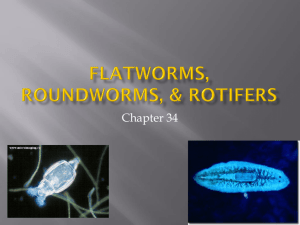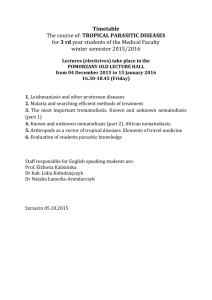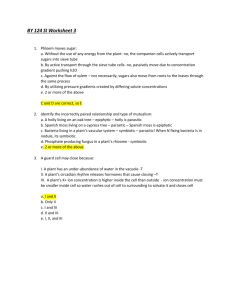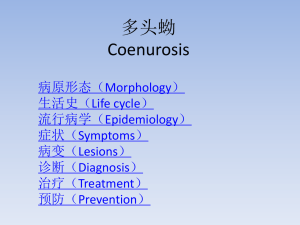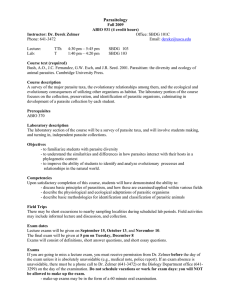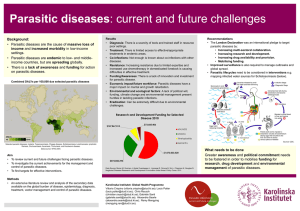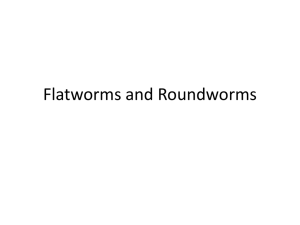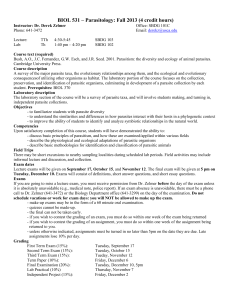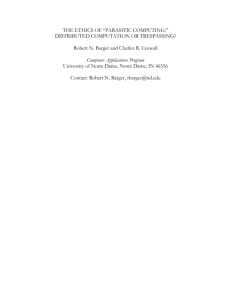XIV. Parasitic Plants (No Chapter) 2011 A. Introduction
advertisement
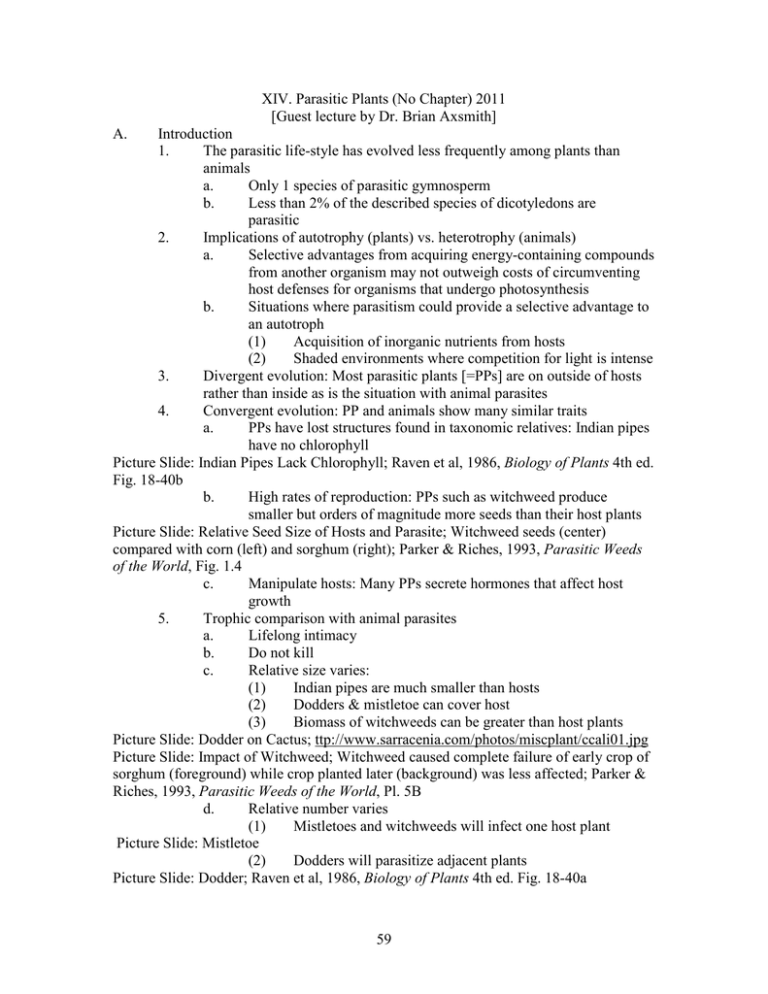
XIV. Parasitic Plants (No Chapter) 2011 [Guest lecture by Dr. Brian Axsmith] A. Introduction 1. The parasitic life-style has evolved less frequently among plants than animals a. Only 1 species of parasitic gymnosperm b. Less than 2% of the described species of dicotyledons are parasitic 2. Implications of autotrophy (plants) vs. heterotrophy (animals) a. Selective advantages from acquiring energy-containing compounds from another organism may not outweigh costs of circumventing host defenses for organisms that undergo photosynthesis b. Situations where parasitism could provide a selective advantage to an autotroph (1) Acquisition of inorganic nutrients from hosts (2) Shaded environments where competition for light is intense 3. Divergent evolution: Most parasitic plants [=PPs] are on outside of hosts rather than inside as is the situation with animal parasites 4. Convergent evolution: PP and animals show many similar traits a. PPs have lost structures found in taxonomic relatives: Indian pipes have no chlorophyll Picture Slide: Indian Pipes Lack Chlorophyll; Raven et al, 1986, Biology of Plants 4th ed. Fig. 18-40b b. High rates of reproduction: PPs such as witchweed produce smaller but orders of magnitude more seeds than their host plants Picture Slide: Relative Seed Size of Hosts and Parasite; Witchweed seeds (center) compared with corn (left) and sorghum (right); Parker & Riches, 1993, Parasitic Weeds of the World, Fig. 1.4 c. Manipulate hosts: Many PPs secrete hormones that affect host growth 5. Trophic comparison with animal parasites a. Lifelong intimacy b. Do not kill c. Relative size varies: (1) Indian pipes are much smaller than hosts (2) Dodders & mistletoe can cover host (3) Biomass of witchweeds can be greater than host plants Picture Slide: Dodder on Cactus; ttp://www.sarracenia.com/photos/miscplant/ccali01.jpg Picture Slide: Impact of Witchweed; Witchweed caused complete failure of early crop of sorghum (foreground) while crop planted later (background) was less affected; Parker & Riches, 1993, Parasitic Weeds of the World, Pl. 5B d. Relative number varies (1) Mistletoes and witchweeds will infect one host plant Picture Slide: Mistletoe (2) Dodders will parasitize adjacent plants Picture Slide: Dodder; Raven et al, 1986, Biology of Plants 4th ed. Fig. 18-40a 59 5. HAUSTORIUM (Plural haustoria) a. Modified structure from roots and stems of PP that penetrate host plant tissues b. Vascular system of PP fuses with vessels of host (Analogous to blood vessels of a parasitic animal fusing with those of its host) Picture Slide: DODDER; Cuscuta europaea on a nettle, arrow indicates position of haustorium B. Examples of parasitic dicotyledons 1. Mistletoes a. Autotrophs: Use own chlorophyll for photosynthesis b. Utilize host plant as a source of water Picture Slide: Mistletoe, Biomass compared to host plant can be relatively large (Green regions on tree are mistletoe.); http://www.sarracenia.com/photos/miscplant/p_spp01.jpg Mistletoe2 2. Dodders (Cuscuta spp.) a. Characteristic yellow thread-like stems cover host plants b. Ability to photosynthesize varies among species (1) One species produces no chlorophyll (= heterotroph) (2) Other species retain photosynthetic capability in tissues near flowers (semi-autotrophic) Picture Slides :Dodder Plant and Flowers; 3. Indian pipes (Monotropa uniflora) a. Plants with white stems and flowers typically found on shaded forest floors near trees b. Do not produce chlorophyll, do not undergo photosynthesis Picture slide: Indian Pipe c. Myco-heterotrophic epiparasites d. Ectomycorrhizal fungi (= EMF) form a mutualistic association with host plants (1) Form a sheath around host root (2) Hyphae penetrate between but not into host cells (3) Break down organic material in soil (4) EMF provide nitrogen and phosphorus to and receive sugars from host plant Picture slides: Diagram of EMF association; plants grown with and without EMF illustration mutualistic association e. Roots of Indian pipe tap into the MYCELIA (= network of hyphae) of EMF (1) Extract sugars from fungus that were produced in tree (2) Since Indian pipe is taking and not exchanging nutrients with fungus, the relationship is parasitic Picture slide: Indian Pipe 4. Witchweeds a. Plant will damage crop plants even before they become visible above ground 60 b. Attach to roots of host plants Picture Slide: Young witchweed plant connected to root of corn host; Parker & Riches, 1993, Parasitic Weeds of the World, Pl. 4B Picture Slide: Witchweed attached to root of host cowpea; Parker & Riches, 1993, Parasitic Weeds of the World, Pl. 7C Picture Slide: Xylem vessels of witchweed connect to xylem of sorghum host root; Parker & Riches, 1993, Parasitic Weeds of the World, Pl. 4A c. Increased root length relative to stem size of host plant Picture Slide: Effects on Host Plants; Soil-root mass in which sorghum had been grown with (left) and without (right) witchweed showing stimulation of host root development by the parasitic plant; Parker & Riches, 1993, Parasitic Weeds of the World, Fig. 1.9 5. Rafflesia arnoldii a. World’s largest flower b. Parasitizes grape vines in jungles of Sumatra c. Pollinated by carrion flies (= odoriferous) Picture Slide Series: Rafflesia arnoldii 1 Day Prior to Opening; Fully Opened; World’s Largest Flower http://www.lostworldarts.com/asia/rafflesia1.htm Rarnoldii1 61
